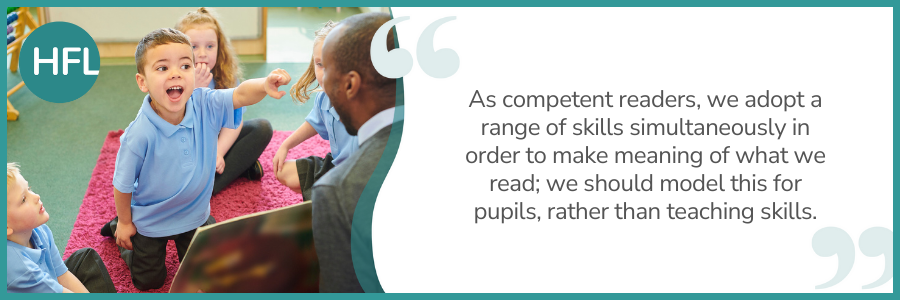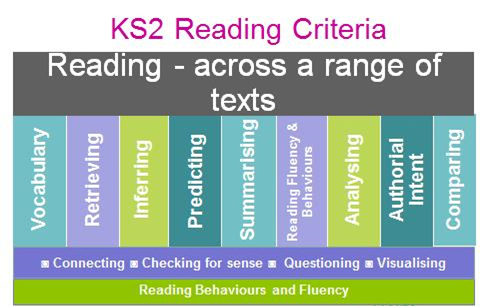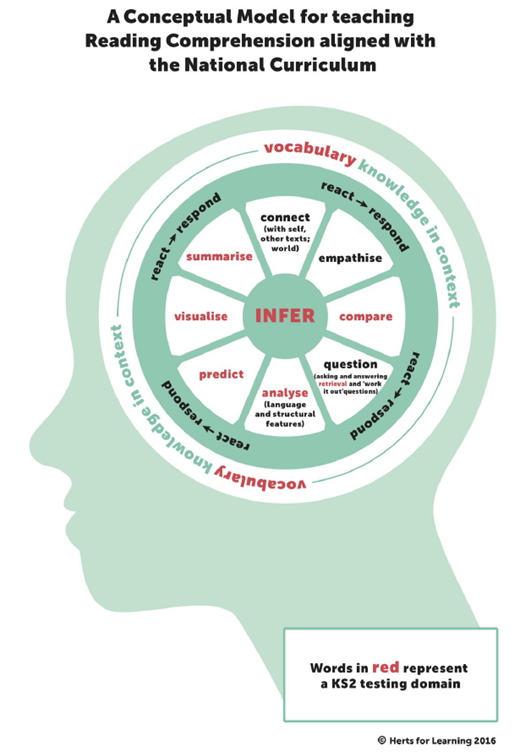
Reading comprehension is complex and for some children, it can feel elusive and mysterious. Much of what goes on when we read happens in our heads and – for expert readers – it is often done with such automaticity so we may not even realise we are doing it. This can make it tricky to help children struggling with reading comprehension for two reasons. Firstly, we may not be aware of the processes happening that we need to teach. Secondly, the children cannot see or hear the processes undertaken by expert readers, unless we choose to explicitly model them.
The DfE’s update to the Reading Framework sets out guidance for teaching reading comprehension. As explored in our latest blog, Reflecting on the DfE Reading Framework, section 10 makes clear that we should ignite children’s reading comprehension through modelling of the various processes used to construct a mental model of a text. As competent readers, we adopt a range of skills simultaneously in order to make meaning of what we read; we should model this for pupils, rather than teaching skills (i.e. vocabulary, inference, prediction) in isolation, to allow them to approach texts in a similar way. This feels like a good way to inspire the will to read, as much as the skill of reading, as we can allow children to respond to what they read in authentic ways.
This guidance has caused consternation for some, who have become used to teaching reading domains separately. Therefore, we thought now would be a good time to re-share this blog written by Penny Slater a few years ago, which reflects on the challenge of teaching reading comprehension and shares some oldie-but-goodie resources that remain useful to this day. Penny’s conceptual model for reading comprehension is also shared, and this is a hugely helpful tool for teachers to understand the ultimate goal of reading – inference – and how we construct meaning in our minds, bringing together the ‘skills’ of reading to reach the desired outcome.
The art of teaching reading comprehension is a troublesome business. For years, I tussled with my lack of clarity in this area, questioning why I found it so difficult to teach something that I found so easy to do. And of course the answer is clear: I struggled to teach the processes involved in comprehension because I was unable to fully articulate the processes that I myself employed when comprehending. Doubtless, I was very good at comprehending – in fact, I would go as far as describing myself as ‘a very good comprehender’ – but as teachers our confidence is often our downfall because sometimes the better we are at something, the harder we find it to teach.
When I actually asked myself what I was doing when comprehending a text, I struggled to identify the steps that I was working through, let alone to name those steps. Clearly, this is not an ideal position for a teacher to find themselves in. After all, if I was going to model these steps to my children so that they could mimic them, I needed to know what to show them, and what to call them. Troublesome indeed!
Thankfully a set of documents were handed to me back in 2005 which helped to set me on a clearer path.
The Comprehension Fliers (as they have come to be known) are a set of three double-page documents outlining in teacher-friendly detail the skills involved in becoming a good comprehender. To say that I found these incredibly useful would be an understatement! Most importantly for me, they gave me a language with which I could begin talking about the silent and invisible processes involved in comprehension. There were also very practical. I valued having a list of activities that I could use with my class, knowing that each one would be helping to develop reading comprehension. They are an easily accessible and wonderfully usable addition to your teaching resource bank.
My relationship with teaching reading comprehension was beginning to become less troublesome. I was now convinced that the act of comprehension was the result of many cognitive processes working together. I wondered whether teaching each skill in isolation would allow children to hone the skills, one at a time, or whether a combined approach would be more beneficial.
I still felt that there was work to be done, specifically in relation to the KS2 reading test. This introduced a whole new raft of language that needed to be assimilated into my developing understanding of reading comprehension. I knew that I didn’t want to teach solely to the test, but I was acutely aware of the fact that the domains outlined in the test development materials would be the aspects of reading that my children would ultimately be judged on. So my teaching had to prepare them for a successful jump through that hoop otherwise I would have a raft of children who had a heightened awareness of the skills involved in comprehension, but who couldn’t actually deliver the goods when needed!
The ‘English reading test framework 2016’ set out how elements of the curriculum will be defined for test development purposes:
2a give / explain the meaning of words in context
2b retrieve and record information / identify key details from fiction and non-fiction
2c summarise main ideas from more than one paragraph
2d make inferences from the text / explain and justify inferences with evidence from the text
2e predict what might happen from details stated and implied
2f identify / explain how information / narrative content is related and contributes to meaning as a whole
2g identify / explain how meaning is enhanced through choice of words and phrases
2h make comparisons within the text
HFL Education re-organised these into a more accessible format, and re-named them in order to make the terms more usable in the classroom.

Still, despite the language being refined for us, and the skills being neatly positioned along a horizontal axis, I was still not confident that all the information available had been pulled together in a workable fashion to support teachers in the classroom. Teaching each skill in isolation, with equal weighting, felt a little problematic - surely there should be a hierarchy of skills involved? Should some receive more air-time than others? Did some logically precede others? Was it possible in fact to teach each skill discretely?
Inference for example, caused me more than a moment of pause for thought. The longer I spent trying to model this skill, the more I came to the realisation that inference was actually the culmination of many skills working together and that teaching it in isolation was both misleading and unsuccessful.
And so, with these questions in my mind, I set about pulling all the strands of reading comprehension together into a visual form that performed several functions. Fundamentally I wanted a model that:
- Showed how the interrelating aspects of effective reading comprehension can be positioned to show a hierarchy – or journey – of skills
- Mirrored the language of the test domains, but cushioned these terms within more useful language that would support wider learning in the classroom
- Included reference to other recognised reading skills that went beyond those outlined in the test development materials
This is the model that I now use to support teachers to develop their understanding of how the skills of reading comprehension inter-relate. Teachers who I have worked with have found it particularly useful to see how the skill of inferring is in fact an end-point, and that in order to support our children in being able to infer, we must pay attention to the other skills that inference relies on. Teachers have also appreciated how the model signifies the importance of vocabulary knowledge. If we consider each circle to be a moat which the children must cross before they are able to access the skills within the innermost circles, then we see clearly that they will not get very far if they do not understand the meanings on the words on the page. This chimes with what teachers are finding in their classrooms: lack of knowledge of vocabulary is a complete blocker. You can’t make any inroads into comprehension without addressing this issue first.

Please feel free to download an A4 printable of the model (Conceptual model for reading comprehension) if you would like to share this back in school.
This Conceptual Model for Reading Comprehension helps us to understand the skills we draw upon as expert readers to make sense of what we read. Modelling these aspects aloud when reading with your class will help children to become aware of the skills readers use, and how they too can apply them to make meaning when reading.
As you read and talk your thoughts aloud, some useful sentence starters might be:
- This reminds me of when… (connect: to life, to books, to wider world)
- What I’m picturing in my mind here is… (visualise)
- I wonder… (question)
- That’s like what happened in… (compare)
- I think that this will/will not… (predict)
Encourage children to do the same, as nurturing these responses will support them well on the road to inference.
If you’re keen to delve deeper into the world of reading comprehension, do dip into our recent blogs:
- Reflecting on the DfE Reading Framework – guidance and reflections on the July 2023 update to the Reading Framework
- Reading SATs knowledge; Reading SATs power – useful for Year 6 teachers to reflect and learn from the Summer 2023 paper
- The Power of Poetry in the Primary Classroom – great for building confidence in the teaching of poetry
- Whole Class Guided Reading in KS2: Finding the Right Balance for All Children – supportive guidance and provocations to ensure all children access quality reading teaching
Original blog by Penny Slater, with additions by Juliet McCullion.



